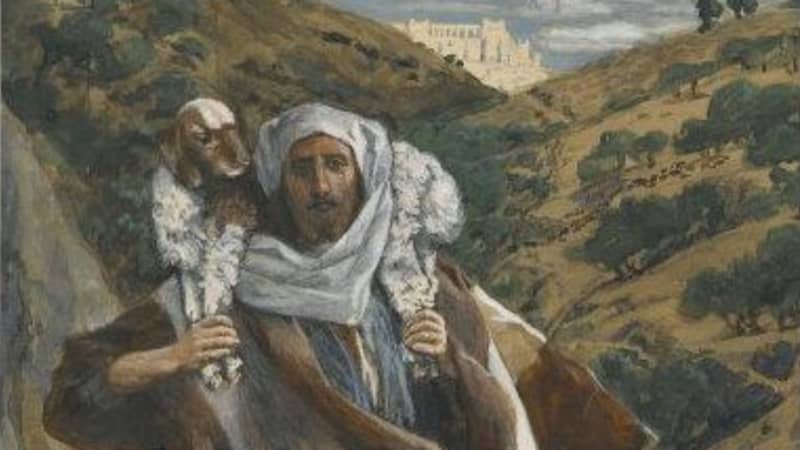Father Flynn opens the play, Doubt: A Parable with a question: “What do you do when you’re not sure?” His sermon continues:
I want to tell you a story: A cargo ship sank, and all her crew was drowned. Only this one sailor survived. He made a raft of some spars and, being of a nautical discipline, turned his eyes to the Heavens and read the stars. He set a course for his home and, exhausted, fell asleep. Clouds rolled in and blanketed the sky. For the next twenty nights, as he floated on the vast ocean, he could no longer see the stars. He thought he was on course, but there was no way to be certain. As the days rolled on, and he wasted away with fevers, thirst and starvation, he began to have doubts. Had he set his course right? Was he still going on towards his home? Or was he horribly lost and doomed to a terrible death? No way to know. The message of the constellations – had he imagined it because of his desperate circumstance? Or had he seen Truth once and now had to hold on to it without further reassurance? That was his dilemma on a voyage without apparent end. There are those of you in church today who know exactly the crisis of faith I describe. I want to say to you. Doubt can be a bond as powerful and sustaining as certainty. When you are lost, you are not alone.
Shanley immediately introduces the concept of how a parable is used to communicate a larger idea to a group: in this context, the larger group being Flynn’s congregation, and ultimately each audience member witnessing this opening sermon. While the term parable is most associated with the teachings of Jesus Christ the concept of parabolic storytelling dates to ancient times. Parabolic storytelling has been used across cultures, religions, and historical periods. But what is the history of parabolic storytelling, how does it function, and why did the playwright use this device as a thread throughout the play?
Parable: Definition and History
A parable, according to Merriam-Webster, “is a story having an ending based on moral attitude, a standard of conduct, or a religious principle.”
Parables, unlike fables, tell a succinct story with a human character at the center of the story. Fables use animals, plants, inanimate objects or forces of nature as characters. While in the context of the play, Father Flynn is in conversation with the Christian parables of Jesus Christ, most specifically The Prodigal Son, the literary genre can be dated back to Ancient Greece and Rome. According to Madeleine I. Boucher in her book, The Parables:
When Jesus preached so strikingly in parables, he did not create a new literary genre. Rather, he made brilliant use of a genre which was already of long tradition and which was familiar to all throughout the Mediterranean world. In Greece and Rome, parables were employed by rhetoricians, politicians and philosophers.
Not only were philosophers like Sophocles and Aristotle using parabolic storytelling in their teachings, eastern religious traditions, such as Buddhism and Hinduism, also use parables to convey teaching. The Jataka Tales in Buddhism are a collection of stories about the previous lives of the Buddha, serving as moral lessons. In Buddhism, the concept of reincarnation is tied to the idea of samsara, the cycle of birth, death, and rebirth. According to Buddhist beliefs, beings are trapped in this cycle due to their attachment and craving. These ancient tales narrate Buddha’s various incarnations before achieving enlightenment as Siddhartha Gautama (who is known as the founder of what we understand as the Buddhist religion today). In these ancient stories that illustrate the essence of the above definition of parable, the central character often is portrayed as the Buddha reincarnated inside the soul of an animal. The interesting thing to note is that while a fable is giving wild animals voices, such as The Wolf in Little Red Riding Hood, the Jataka Tales are giving the Buddha a voice through each phase of his reincarnation no matter what form that is taking. The Jataka Tales serve, just like Christian parables, as moral lessons and illustrate the qualities one should cultivate, such as compassion and selflessness, to break free from the cycle of rebirth and attain what the Buddhist’s refer to as nirvana, a state in which desire and one’s conscious attachment to things in secular life are removed through meditation.

A Bhutanese painting of the Jatakas from the 18th or 19th century.
The Jataka Tales, which many scholars refer to as Buddhist parables, illustrates virtues and ethical principles through engaging narratives. They were compiled and written down over centuries, with the earliest versions likely transmitted orally. Eugene Watson Burlingame puts forth in his book, Buddhist Parables, that:
[T]he stories were collected gradually and organized during different periods of Indian history with the original being traced back to ancient India, where the Buddha, as part of his teaching, shared these stories with his followers. Jataka translates to birth or origin which are stories that focus on the Buddha’s past lives before attaining enlightenment.
Each story features the Buddha or another human character in various forms (including animal form) engaging in acts of virtue, compassion, or wisdom. While The Jataka Tales focuses on the journeys of Buddha, another type of Buddhist stories called the Avadânas have a broader scope. The Avadânas encompass a variety of characters and themes that go beyond the Buddha’s journey. Below is an example of an ancient avadânas as recorded by author Wei Li in their article “From the Imagination to the Reality: Historical Aspects of Rewriting Six Dynasties Buddhist Avadāna Stories.”
Once upon a time, a parrot flew to a mountain, where all the animals and birds lived in harmony and love for one another, not harming each other. The parrot mused to itself, “Even though this is nice, I cannot stay longer and I shall return. He then left. Yet a few months later, the mountain became engulfed in fire. When the parrot noticed it from a distance, it dove into the water, scooped it up with its wings, and flew up into the air, dousing the flames with water from its feathers. And it went on like this. The deities of the sky said, “What a silly parrot! Why are you so stupid? Would you rather have a thousand miles of fire extinguished by the water of your two wings?” The parrot said to them, “How can I not put out the fire when I know about it. I have been a guest in the mountain, and all the birds and animals there are kind and good, and I cannot bear to see them (suffering)”. The deities of the heavens felt his kindness and extinguished the fire with rain.
In Israel, parables were uttered by prophets and wise women and men. They appear even in the oldest books of the Old Testament. Parables were often used by Jewish rabbis who were contemporaries of Jesus. The parables which most closely resemble Jesus’s are those in the Old Testament and rabbinic literature. These Semitic parables (as distinct from the classical) are no doubt the predecessors of those we find preserved in the Synoptic Gospels. The Synoptic Gospels refer to the three biblical Gospels of Matthew, Mark, and Luke in the New Testament of the Christian Bible. Matthew, Mark, and Luke recounted the same stories and teachings of Jesus Christ using their own voices. Scholars studying these gospels have been able to see clear similarities and links as opposed to the Gospel of John whose stories do not take the same common view on all accounts.
The Christian parables of Jesus Christ in the Synoptic Gospels, according to many scholars, were directly in conversation with the oral traditions and other written sources from the cultures that came before. Father Flynn, in Shanley’s play, is also directly in conversation with the parables of Jesus Christ. So how exactly do these parables function, and why do we still find ourselves in conversation with these teachings centuries later?
What Makes a Story a Parable?
The essence of a parable lies in its ability to convey profound truths or moral lessons through a concise and relatable narrative. From the transcripts of PBS Frontline’s documentary series titled From Jesus to Christ, scholars state:
Parables make demands on their hearers/readers; they have ethical implications. Their goal is not just to persuade people to see the world, God, themselves, or other human beings in strikingly new ways; parables also demand that their hearers/readers respond in concrete actions by putting those new or changed perceptions into practice in their everyday lives.
Father Flynn is challenging the audience from the start of the play to think about their own relationship between faith and doubt. According to scholars, parabolic storytelling can be broken down into the following categories: similitudes, parables, and exemplary stories.
Similitudes are parables that draw parallels or comparisons between familiar situations and deeper truths. They often use everyday scenarios or common experiences to convey a more profound message. An example of a similitude is discussion of the mustard seed found in the Synoptic Gospels. Jesus compares the Kingdom of Heaven to a mustard seed, the smallest seed that has the ability, when planted to grow into a large tree, providing shelter for birds. A common religious saying is “having a mustard seed of faith,” which is an understanding that even having a tiny belief can grow into something significant.
Parables refers to a simple, succinct story that illustrates a moral or spiritual lesson. The Parable of The Good Samaritan, found in the Gospel of Luke (Luke 10:25 – 37), is a well-known parable. The story recounts a compassionate traveler who helps a wounded stranger on the road, emphasizing the importance of compassion and neighborly love.
Exemplary Stories serve as models or examples for the audience to follow. They focus on depicting individuals who embody virtues or principles, encouraging audiences to emulate their actions. An example is the Parable of the Lost Sheep, which is found in the Gospel of Matthew (Matthew 18:10 – 14) and the Gospel of Luke (Luke 15:3 – 7). A shepherd had a flock of a hundred sheep, but one of them went astray. Concerned for the lost sheep, the shepherd left the ninety-nine in the open country and went in search of the one that was lost. When he found the lost sheep, he joyfully placed it on his shoulders and returned home. The shepherd then called together his friends and neighbors to celebrate, saying that there is more joy in heaven over one sinner who repents than over ninety-nine righteous people who do not need to repent.

The Good Shepherd, painted by James Tissot between 1886 and 1894, from the collection of the Brooklyn Museum.
As evidenced by the above examples, a parable has a dual purpose. It not only is a compelling story but conveys a deeper moral or spiritual message. The simplicity and universality of parables make them powerful tools for communicating complex ideas, such as doubt and faith, and guiding individuals toward ethical or virtuous behavior. When the curtain is pulled back on the play and its relationship to parabolic storytelling, one can see that doubt colors the entire analysis of the play itself.
References:
|
Note: Members of the New York Public Library can access JSTOR and many other research databases through the library’s Articles & Databases page. Allen, Hubert J. B. "The Parables of Christ are Timeless: An example of Roland Allen’s originality introduced by his grandson." Transformation, vol. 29, no. 3, July 2012, pp. 186-188. Boucher, Madeleine I. The Parables. Revised Edition, 2nd printing, Michael Glazier, Inc, 1986. Brantley, Ben. "A Nun Who Is Certain, Even if Truth Is Not." The New York Times, 24 Nov. 2004. Bryan, David K. "Transformation of the Mustard Seed and Leaven in the Gospel of Luke." Novum Testament, vol. 58, no. 2, 2016, pp. 115-134. Burlingame, Eugene Watson. Buddhist Parables Translated from the original Pāli. Yale University Press, 1922. Cullingford, Elizabeth. "Evil, Sin, or Doubt? The Dramas of Clerical Child Abuse." Theatre Journal, vol. 62, no. 2, May 2010, pp. 245-263. Cunneen, Joseph. "The Good Samaritan: Parable of Renewal." CrossCurrents, vol. 46, no. 3, Fall 1996, pp. 291-292. Davies, Stevan. "A Cycle of Jesus's Parables." The Biblical Archaeologist, vol. 46, no. 1, Winter 1983, pp. 15-17. Dodd, C.H. The Parables of the Kingdom. London, James Nisbet and Company, 1935. Fine, Gary Alan. "Review: doubtful." Contexts, vol. 5, no. 2, Spring 2006, pp. 70-71. Gowler, David B. What Are They Saying About the Parables? Second Edition, Paulist Press, 2021. Helman, Cecil. "Parables." Ambit, no. 51, 1972, pp. 14-16. Li, Wei "From the Imagination to the Reality: Historical Aspects of Rewriting Six Dynasties Buddhist Avadāna Stories." Religions, vol. 14, no. 4, 2023, article 545. Moughty, Sarah. “From Jesus to Christ: The First Christians.” FRONTLINE, 1 Dec. 2017. Narayan, Dr. Sonam. "Indian Short Stories and Their Development." Shodhshauryam, International Scientific Refereed Research Journal, vol. 6, no. 3, 2023, SHISRRJ, pp. [38-46]. ISSN : 2581-6306. |



